Attached files
| file | filename |
|---|---|
| 8-K - FORM 8-K - NEW YORK COMMUNITY BANCORP INC | d631738d8k.htm |

Third Quarter 2018 Investor Presentation Exhibit 99.1
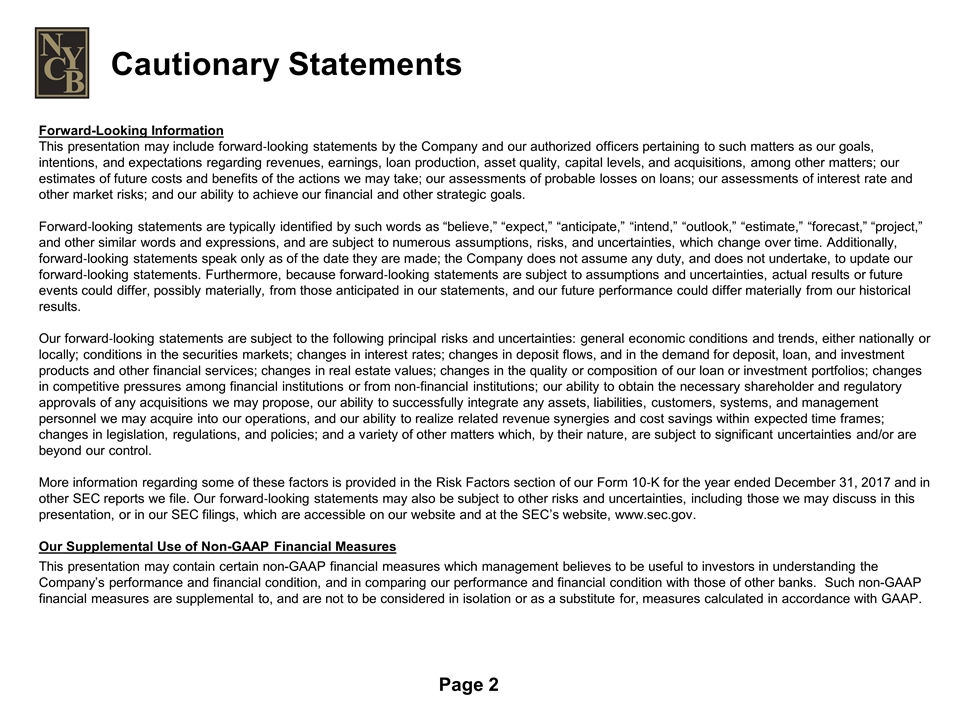
Forward-Looking Information This presentation may include forward‐looking statements by the Company and our authorized officers pertaining to such matters as our goals, intentions, and expectations regarding revenues, earnings, loan production, asset quality, capital levels, and acquisitions, among other matters; our estimates of future costs and benefits of the actions we may take; our assessments of probable losses on loans; our assessments of interest rate and other market risks; and our ability to achieve our financial and other strategic goals. Forward‐looking statements are typically identified by such words as “believe,” “expect,” “anticipate,” “intend,” “outlook,” “estimate,” “forecast,” “project,” and other similar words and expressions, and are subject to numerous assumptions, risks, and uncertainties, which change over time. Additionally, forward‐looking statements speak only as of the date they are made; the Company does not assume any duty, and does not undertake, to update our forward‐looking statements. Furthermore, because forward‐looking statements are subject to assumptions and uncertainties, actual results or future events could differ, possibly materially, from those anticipated in our statements, and our future performance could differ materially from our historical results. Our forward‐looking statements are subject to the following principal risks and uncertainties: general economic conditions and trends, either nationally or locally; conditions in the securities markets; changes in interest rates; changes in deposit flows, and in the demand for deposit, loan, and investment products and other financial services; changes in real estate values; changes in the quality or composition of our loan or investment portfolios; changes in competitive pressures among financial institutions or from non‐financial institutions; our ability to obtain the necessary shareholder and regulatory approvals of any acquisitions we may propose, our ability to successfully integrate any assets, liabilities, customers, systems, and management personnel we may acquire into our operations, and our ability to realize related revenue synergies and cost savings within expected time frames; changes in legislation, regulations, and policies; and a variety of other matters which, by their nature, are subject to significant uncertainties and/or are beyond our control. More information regarding some of these factors is provided in the Risk Factors section of our Form 10‐K for the year ended December 31, 2017 and in other SEC reports we file. Our forward‐looking statements may also be subject to other risks and uncertainties, including those we may discuss in this presentation, or in our SEC filings, which are accessible on our website and at the SEC’s website, www.sec.gov. Our Supplemental Use of Non-GAAP Financial Measures This presentation may contain certain non-GAAP financial measures which management believes to be useful to investors in understanding the Company’s performance and financial condition, and in comparing our performance and financial condition with those of other banks. Such non-GAAP financial measures are supplemental to, and are not to be considered in isolation or as a substitute for, measures calculated in accordance with GAAP. Cautionary Statements
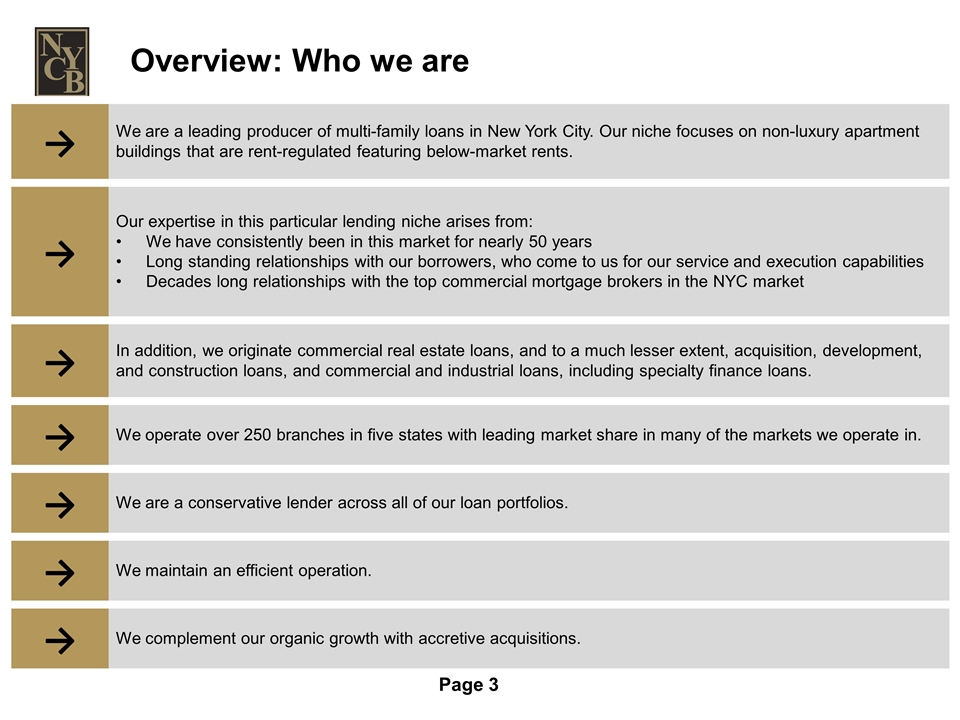
→ We are a leading producer of multi-family loans in New York City. Our niche focuses on non-luxury apartment buildings that are rent-regulated featuring below-market rents. → Our expertise in this particular lending niche arises from: We have consistently been in this market for nearly 50 years Long standing relationships with our borrowers, who come to us for our service and execution capabilities Decades long relationships with the top commercial mortgage brokers in the NYC market → In addition, we originate commercial real estate loans, and to a much lesser extent, acquisition, development, and construction loans, and commercial and industrial loans, including specialty finance loans. → We operate over 250 branches in five states with leading market share in many of the markets we operate in. → We are a conservative lender across all of our loan portfolios. → We maintain an efficient operation. → We complement our organic growth with accretive acquisitions. Overview: Who we are
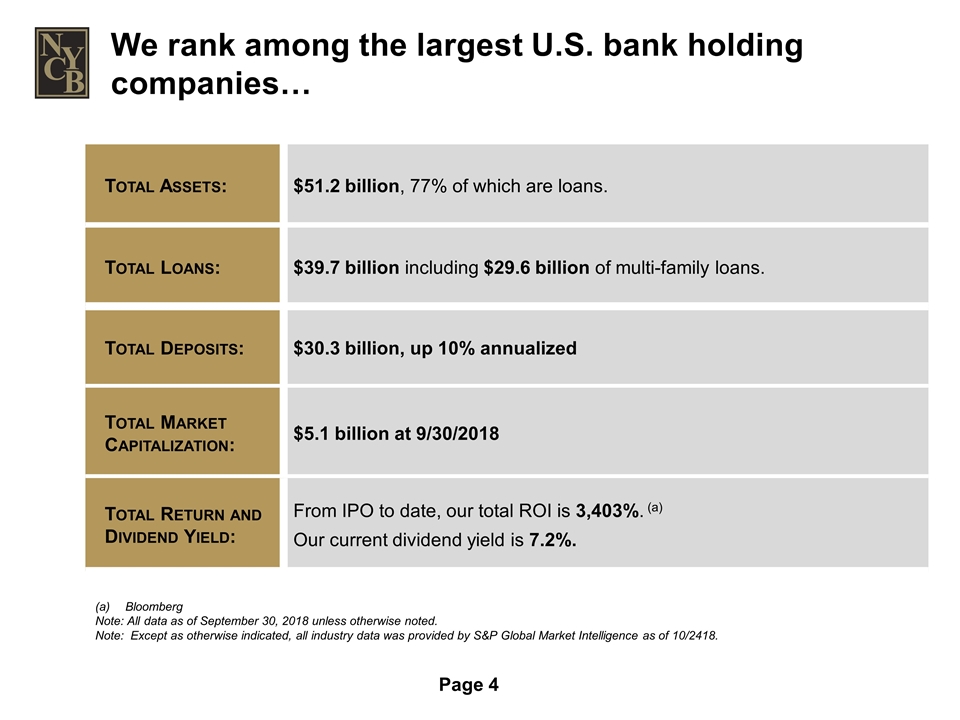
We rank among the largest U.S. bank holding companies… Total Assets: $51.2 billion, 77% of which are loans. Total Deposits: $30.3 billion, up 10% annualized Total Loans: $39.7 billion including $29.6 billion of multi-family loans. Total Market Capitalization: $5.1 billion at 9/30/2018 Total Return and Dividend Yield: From IPO to date, our total ROI is 3,403%. (a) Our current dividend yield is 7.2%. Bloomberg Note: All data as of September 30, 2018 unless otherwise noted. Note: Except as otherwise indicated, all industry data was provided by S&P Global Market Intelligence as of 10/2418.
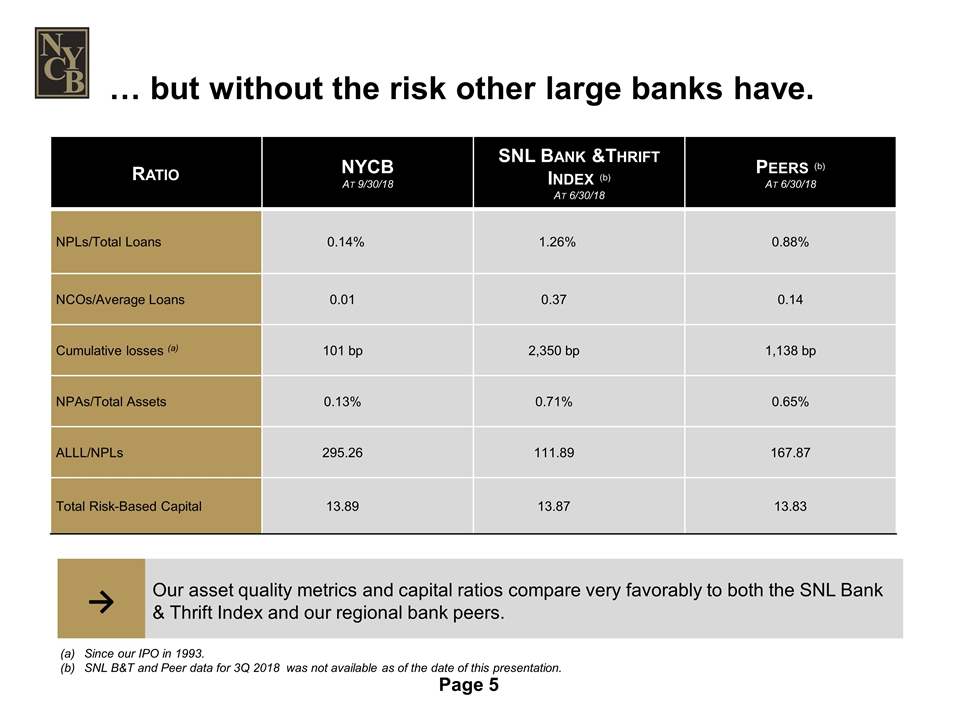
… but without the risk other large banks have. Ratio NYCB At 9/30/18 SNL Bank &Thrift Index (b) At 6/30/18 Peers (b) At 6/30/18 NPLs/Total Loans 0.14% 1.26% 0.88% NCOs/Average Loans 0.01 0.37 0.14 Cumulative losses (a) 101 bp 2,350 bp 1,138 bp NPAs/Total Assets 0.13% 0.71% 0.65% ALLL/NPLs 295.26 111.89 167.87 Total Risk-Based Capital 13.89 13.87 13.83 → Our asset quality metrics and capital ratios compare very favorably to both the SNL Bank & Thrift Index and our regional bank peers. Since our IPO in 1993. SNL B&T and Peer data for 3Q 2018 was not available as of the date of this presentation.

Metro New York 141 branches Total Deposits: $18.8 bn New Jersey 43 branches Total deposits: $4.4 bn Ohio 28 branches Total Deposits: $2.2 bn Florida 27 branches Total Deposits: $2.9 bn Arizona 14 branches Total Deposits: $1.3 bn Our Franchise: A Compilation of Community Banks... → The combined GDP of the five states we operate in is equal to the fourth largest GDP in the world. Note: Data as of 6/30/2018 from S&P Global Market Intelligence
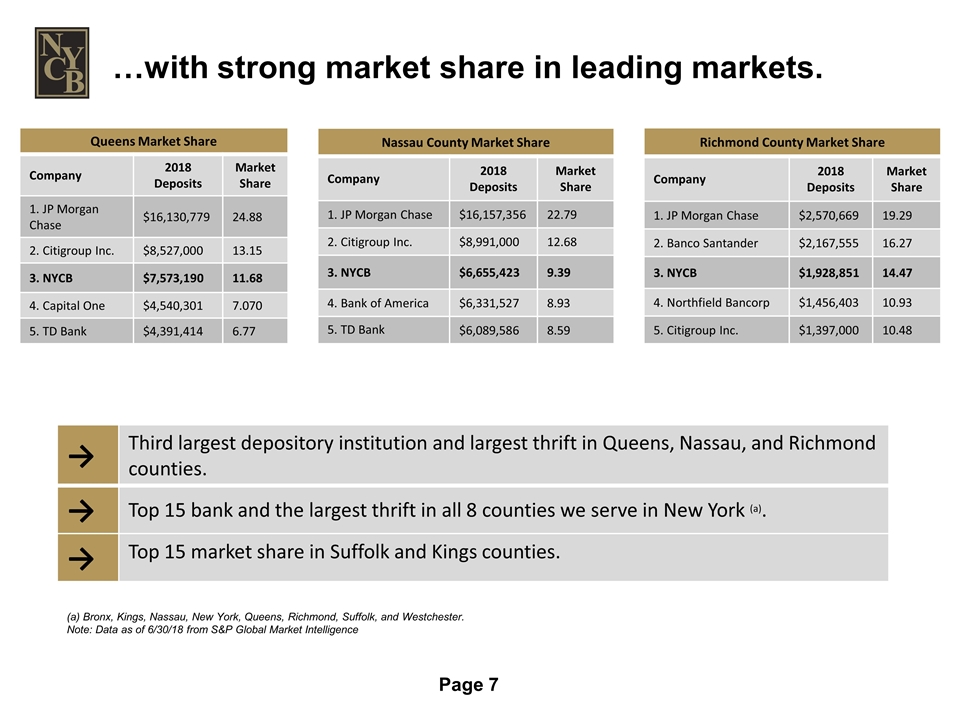
…with strong market share in leading markets. → Third largest depository institution and largest thrift in Queens, Nassau, and Richmond counties. → Top 15 bank and the largest thrift in all 8 counties we serve in New York (a). → Top 15 market share in Suffolk and Kings counties. (a) Bronx, Kings, Nassau, New York, Queens, Richmond, Suffolk, and Westchester. Note: Data as of 6/30/18 from S&P Global Market Intelligence Queens Market Share Company 2018 Deposits Market Share 1. JP Morgan Chase $16,130,779 24.88 2. Citigroup Inc. $8,527,000 13.15 3. NYCB $7,573,190 11.68 4. Capital One $4,540,301 7.070 5. TD Bank $4,391,414 6.77 Nassau County Market Share Company 2018 Deposits Market Share 1. JP Morgan Chase $16,157,356 22.79 2. Citigroup Inc. $8,991,000 12.68 3. NYCB $6,655,423 9.39 4. Bank of America $6,331,527 8.93 5. TD Bank $6,089,586 8.59 Richmond County Market Share Company 2018 Deposits Market Share 1. JP Morgan Chase $2,570,669 19.29 2. Banco Santander $2,167,555 16.27 3. NYCB $1,928,851 14.47 4. Northfield Bancorp $1,456,403 10.93 5. Citigroup Inc. $1,397,000 10.48

3Q 2018 Performance Highlights
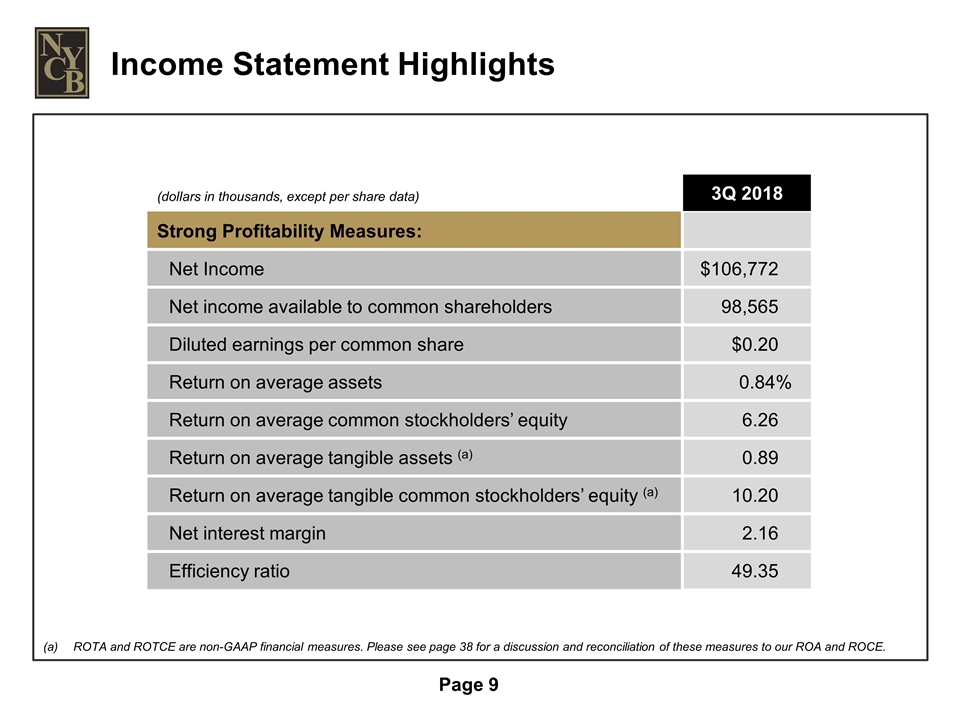
(dollars in thousands, except per share data) 3Q 2018 Strong Profitability Measures: Net Income $106,772 Net income available to common shareholders 98,565 Diluted earnings per common share $0.20 Return on average assets 0.84% Return on average common stockholders’ equity 6.26 Return on average tangible assets (a) 0.89 Return on average tangible common stockholders’ equity (a) 10.20 Net interest margin 2.16 Efficiency ratio 49.35 Income Statement Highlights ROTA and ROTCE are non-GAAP financial measures. Please see page 38 for a discussion and reconciliation of these measures to our ROA and ROCE.
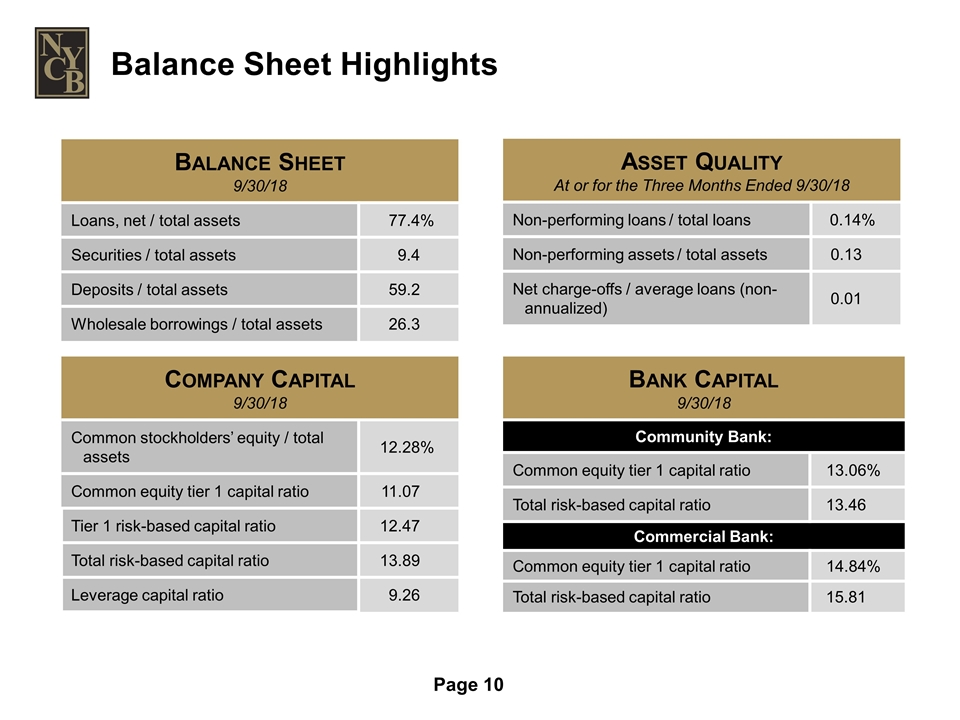
Company Capital 9/30/18 Common stockholders’ equity / total assets 12.28% Common equity tier 1 capital ratio 11.07 Tier 1 risk-based capital ratio 12.47 Total risk-based capital ratio 13.89 Leverage capital ratio 9.26 Bank Capital 9/30/18 Community Bank: Common equity tier 1 capital ratio 13.06% Total risk-based capital ratio 13.46 Commercial Bank: Common equity tier 1 capital ratio 14.84% Total risk-based capital ratio 15.81 Balance Sheet 9/30/18 Loans, net / total assets 77.4% Securities / total assets 9.4 Deposits / total assets 59.2 Wholesale borrowings / total assets 26.3 Asset Quality At or for the Three Months Ended 9/30/18 Non-performing loans / total loans 0.14% Non-performing assets / total assets 0.13 Net charge-offs / average loans (non-annualized) 0.01 Balance Sheet Highlights
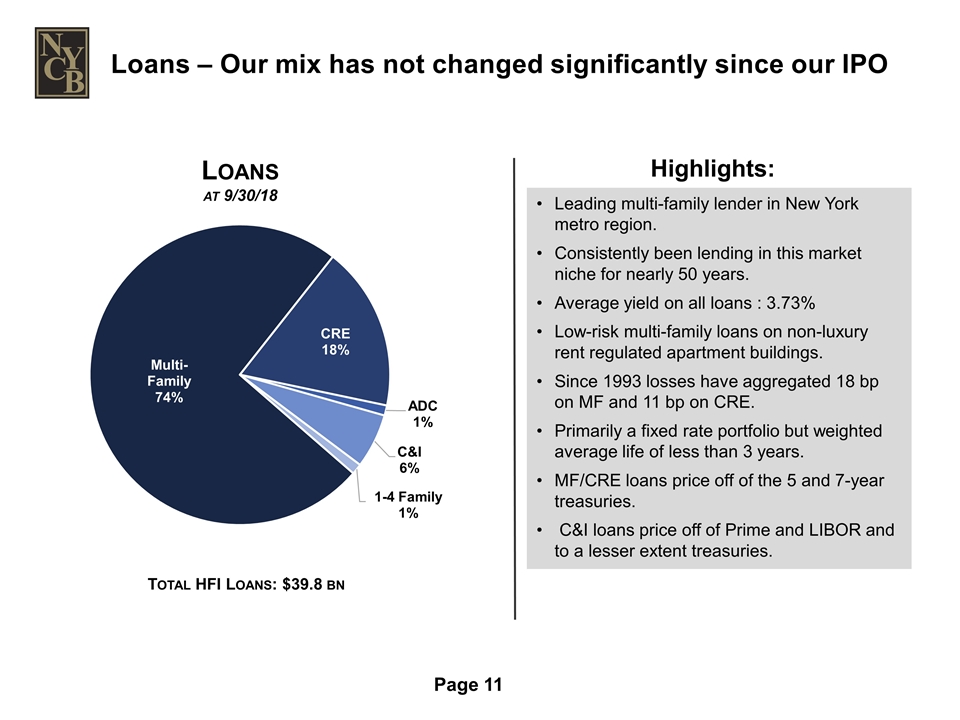
Total HFI Loans: $39.8 bn Loans at 9/30/18 Loans – Our mix has not changed significantly since our IPO Leading multi-family lender in New York metro region. Consistently been lending in this market niche for nearly 50 years. Average yield on all loans : 3.73% Low-risk multi-family loans on non-luxury rent regulated apartment buildings. Since 1993 losses have aggregated 18 bp on MF and 11 bp on CRE. Primarily a fixed rate portfolio but weighted average life of less than 3 years. MF/CRE loans price off of the 5 and 7-year treasuries. C&I loans price off of Prime and LIBOR and to a lesser extent treasuries. Highlights:
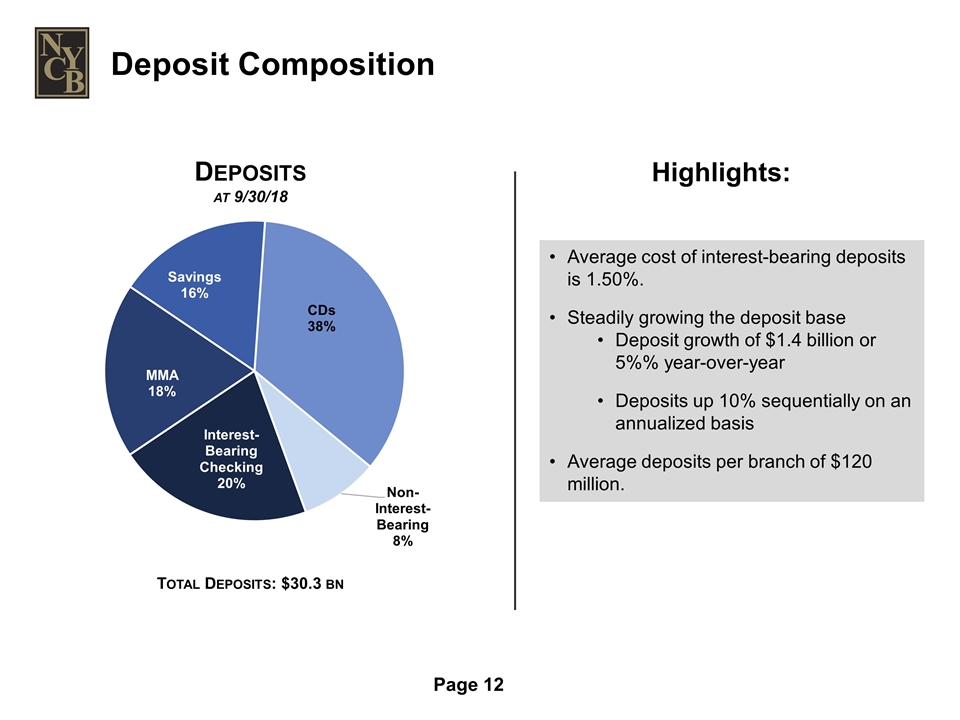
Total Deposits: $30.3 bn Deposits at 9/30/18 Deposit Composition Average cost of interest-bearing deposits is 1.50%. Steadily growing the deposit base Deposit growth of $1.4 billion or 5%% year-over-year Deposits up 10% sequentially on an annualized basis Average deposits per branch of $120 million. Highlights:
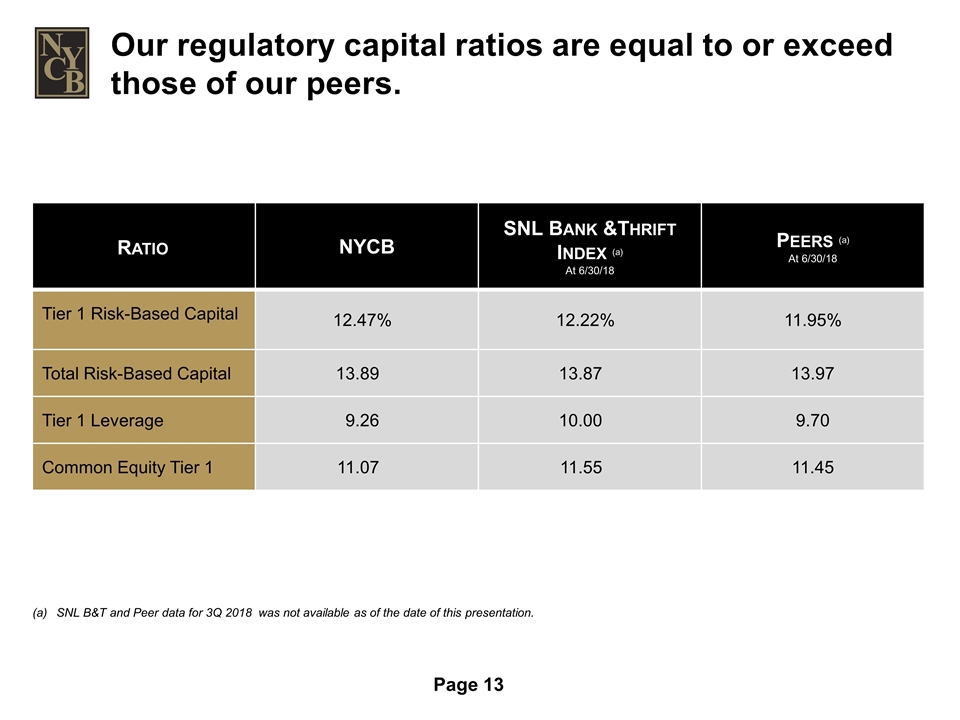
Our regulatory capital ratios are equal to or exceed those of our peers. Ratio NYCB SNL Bank &Thrift Index (a) At 6/30/18 Peers (a) At 6/30/18 Tier 1 Risk-Based Capital 12.47% 12.22% 11.95% Total Risk-Based Capital 13.89 13.87 13.97 Tier 1 Leverage 9.26 10.00 9.70 Common Equity Tier 1 11.07 11.55 11.45 SNL B&T and Peer data for 3Q 2018 was not available as of the date of this presentation.

Looking Forward
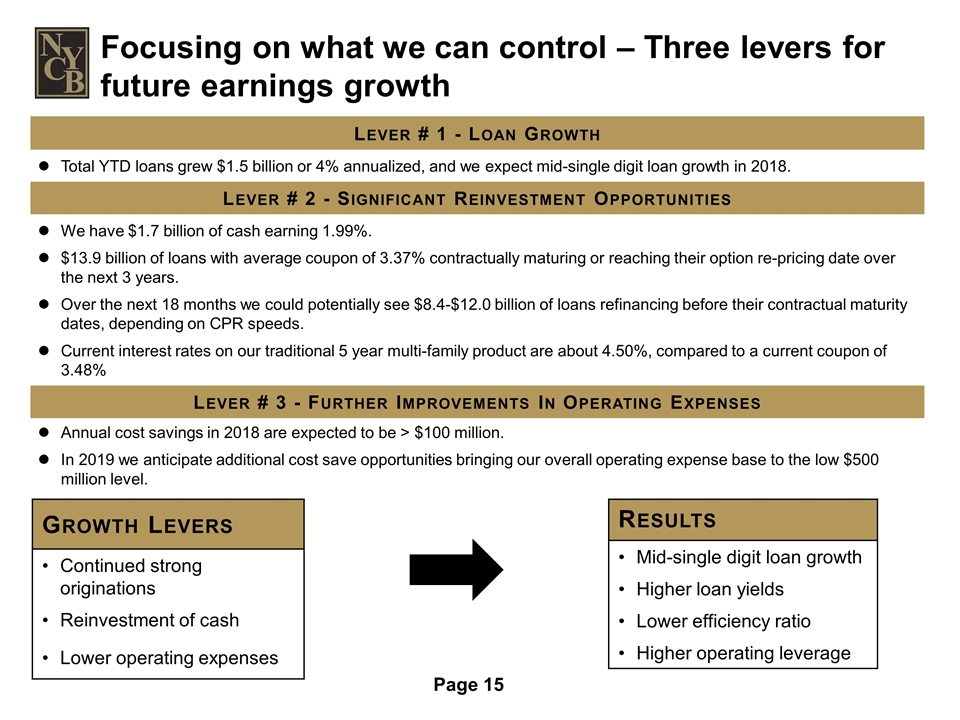
Lever # 1 - Loan Growth Total YTD loans grew $1.5 billion or 4% annualized, and we expect mid-single digit loan growth in 2018. Lever # 2 - Significant Reinvestment Opportunities We have $1.7 billion of cash earning 1.99%. $13.9 billion of loans with average coupon of 3.37% contractually maturing or reaching their option re-pricing date over the next 3 years. Over the next 18 months we could potentially see $8.4-$12.0 billion of loans refinancing before their contractual maturity dates, depending on CPR speeds. Current interest rates on our traditional 5 year multi-family product are about 4.50%, compared to a current coupon of 3.48% Lever # 3 - Further Improvements In Operating Expenses Annual cost savings in 2018 are expected to be > $100 million. In 2019 we anticipate additional cost save opportunities bringing our overall operating expense base to the low $500 million level. Focusing on what we can control – Three levers for future earnings growth Growth Levers Continued strong originations Reinvestment of cash Lower operating expenses Results Mid-single digit loan growth Higher loan yields Lower efficiency ratio Higher operating leverage
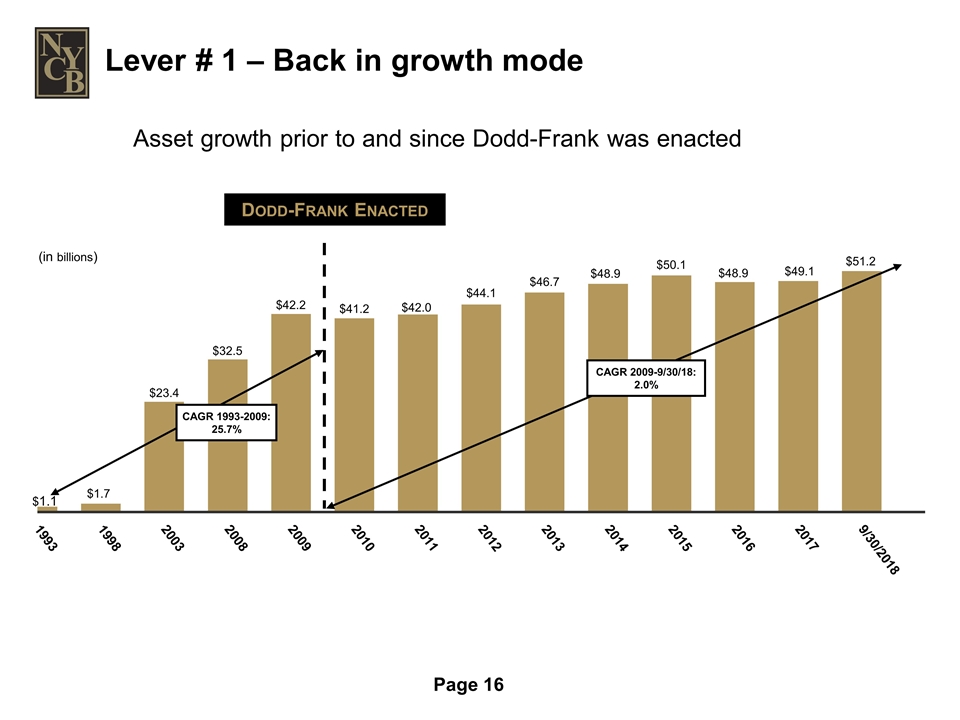
CAGR 1993-2009: 25.7% CAGR 2009-9/30/18: 2.0% Dodd-Frank Enacted Lever # 1 – Back in growth mode Asset growth prior to and since Dodd-Frank was enacted
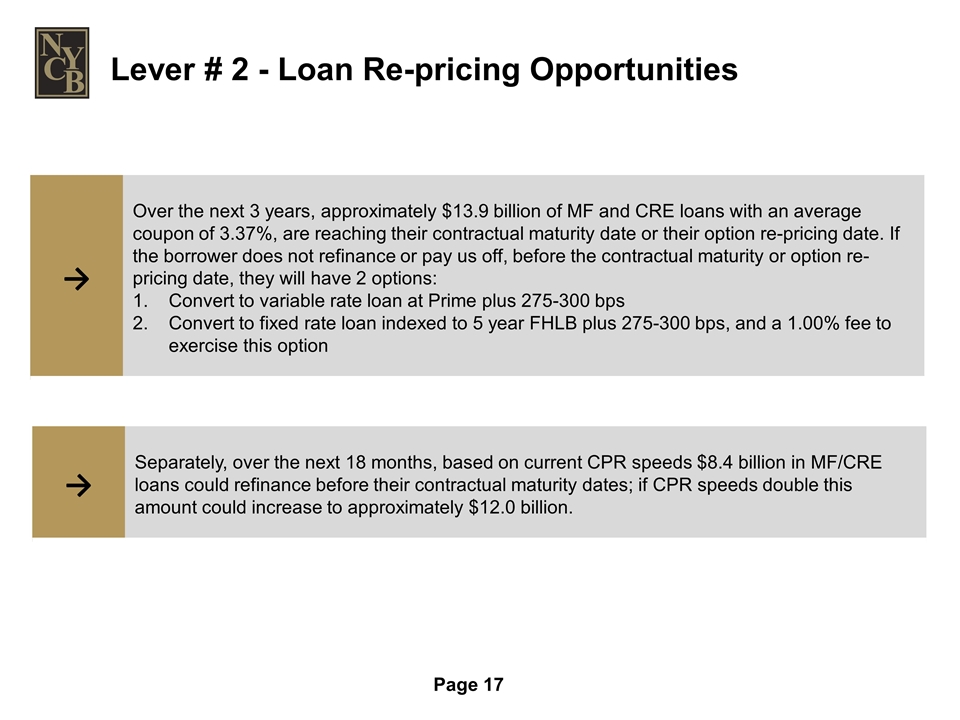
Lever # 2 - Loan Re-pricing Opportunities → Over the next 3 years, approximately $13.9 billion of MF and CRE loans with an average coupon of 3.37%, are reaching their contractual maturity date or their option re-pricing date. If the borrower does not refinance or pay us off, before the contractual maturity or option re-pricing date, they will have 2 options: Convert to variable rate loan at Prime plus 275-300 bps Convert to fixed rate loan indexed to 5 year FHLB plus 275-300 bps, and a 1.00% fee to exercise this option → Separately, over the next 18 months, based on current CPR speeds $8.4 billion in MF/CRE loans could refinance before their contractual maturity dates; if CPR speeds double this amount could increase to approximately $12.0 billion.
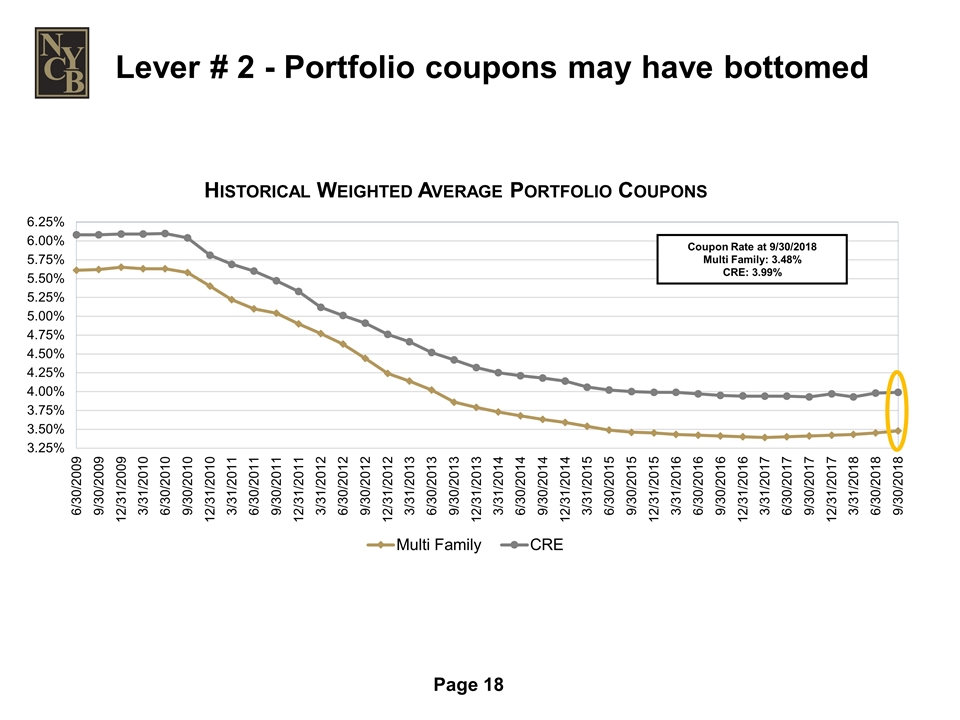
Lever # 2 - Portfolio coupons may have bottomed Coupon Rate at 9/30/2018 Multi Family: 3.48% CRE: 3.99%

NYCB Efficiency Ratio Prior to and Since Dodd-Frank Our efficiency ratio has increased significantly since the enactment of Dodd-Frank. We expect substantial cost savings in the remainder of 2018 and into 2019 on top of regulatory-related cost savings. Lever # 3 – Lower operating expenses We have already expended significant costs to prepare for SIFI; with the threshold being raised to $250 billion in assets and the elimination of many regulatory requirements, the risk of higher SIFI-related expenses is eliminated.
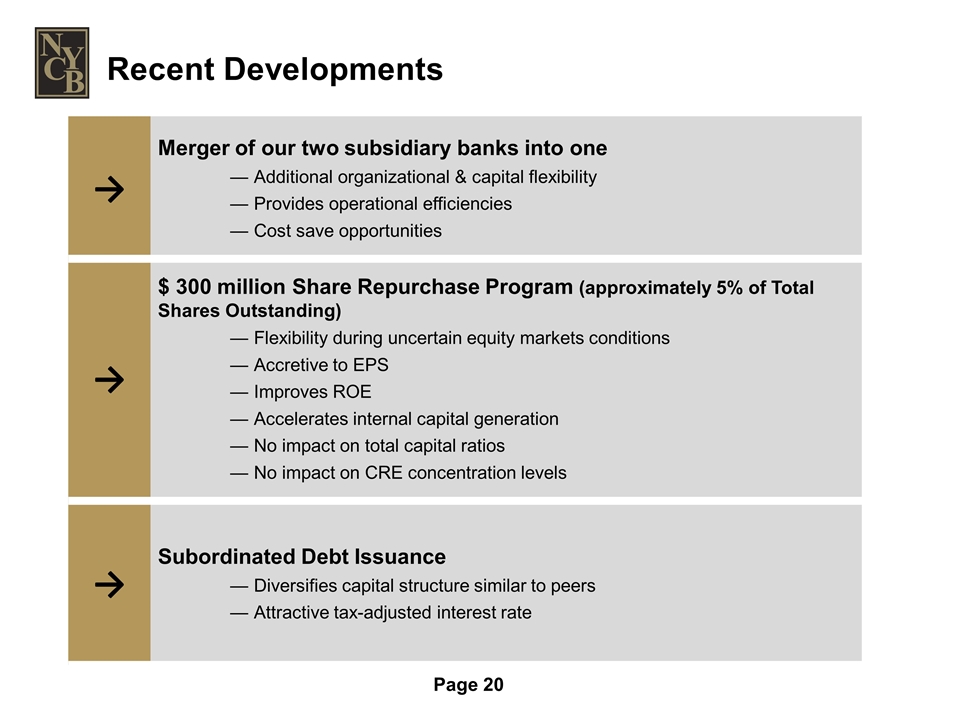
→ $ 300 million Share Repurchase Program (approximately 5% of Total Shares Outstanding) Flexibility during uncertain equity markets conditions Accretive to EPS Improves ROE Accelerates internal capital generation No impact on total capital ratios No impact on CRE concentration levels → Subordinated Debt Issuance Diversifies capital structure similar to peers Attractive tax-adjusted interest rate → Merger of our two subsidiary banks into one Additional organizational & capital flexibility Provides operational efficiencies Cost save opportunities Recent Developments
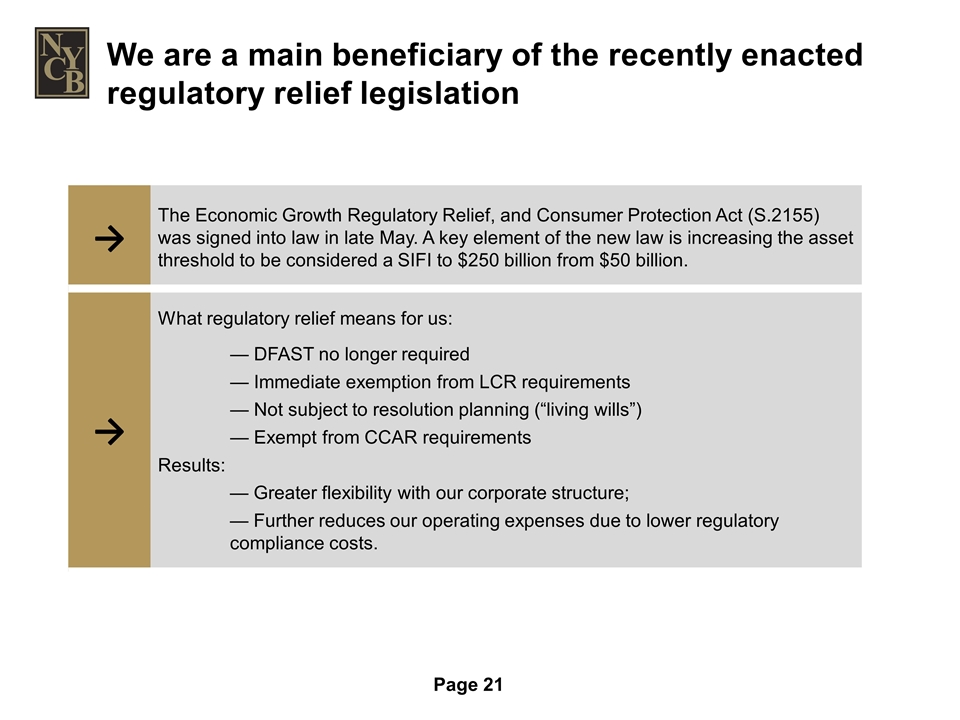
→ The Economic Growth Regulatory Relief, and Consumer Protection Act (S.2155) was signed into law in late May. A key element of the new law is increasing the asset threshold to be considered a SIFI to $250 billion from $50 billion. → What regulatory relief means for us: DFAST no longer required Immediate exemption from LCR requirements Not subject to resolution planning (“living wills”) Exempt from CCAR requirements Results: Greater flexibility with our corporate structure; Further reduces our operating expenses due to lower regulatory compliance costs. We are a main beneficiary of the recently enacted regulatory relief legislation
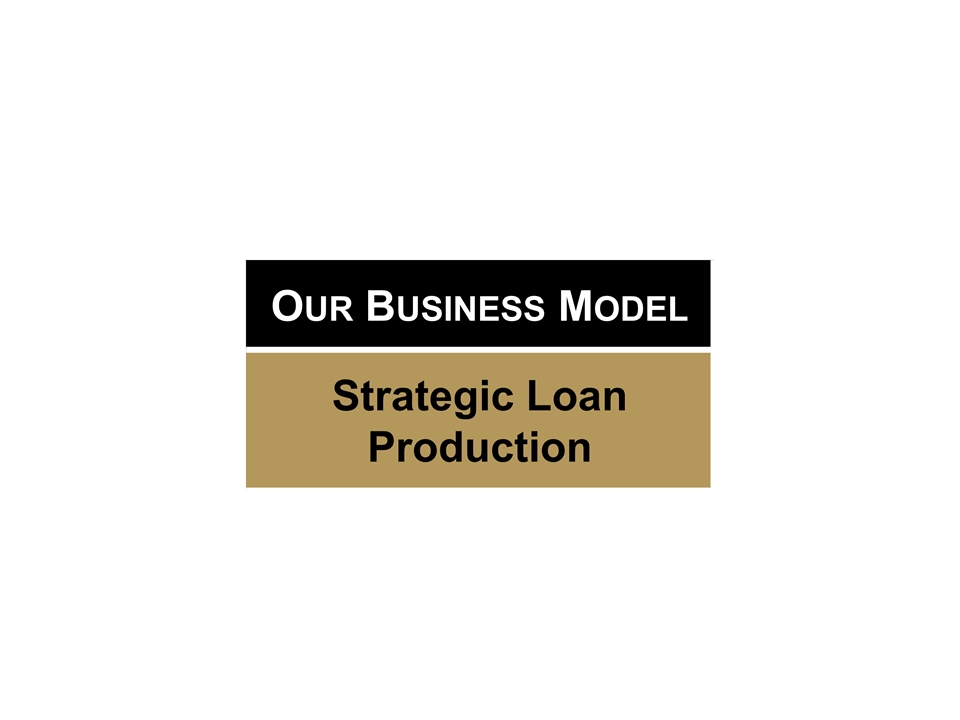
Our Business Model Strategic Loan Production
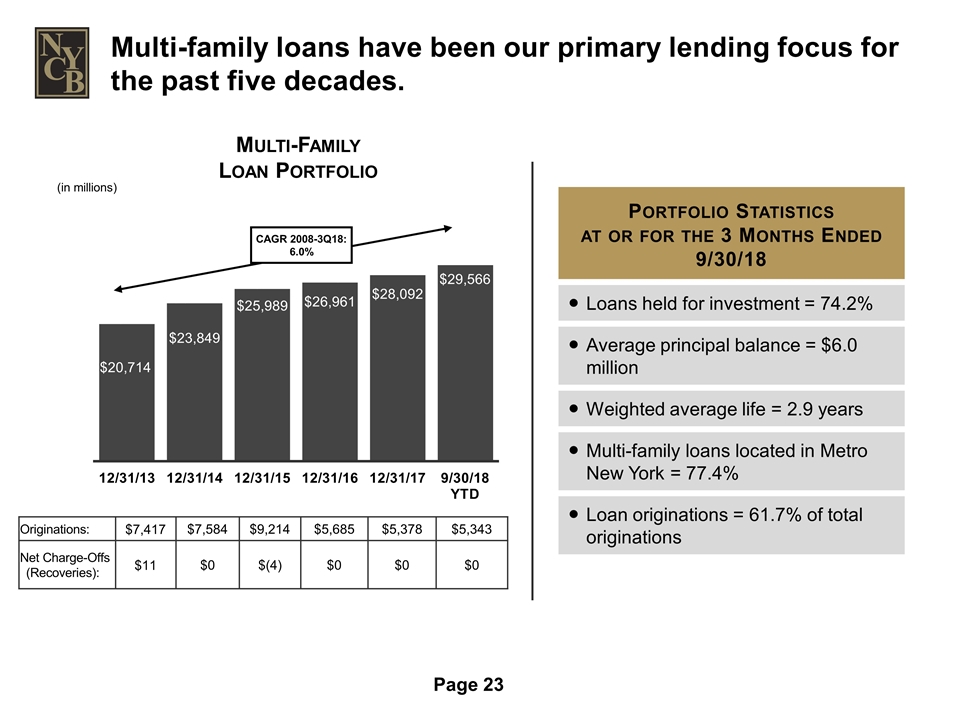
Portfolio Statistics at or for the 3 Months Ended 9/30/18 Loans held for investment = 74.2% Average principal balance = $6.0 million Weighted average life = 2.9 years Multi-family loans located in Metro New York = 77.4% Loan originations = 61.7% of total originations Multi-Family Loan Portfolio (in millions) Originations: $7,417 $7,584 $9,214 $5,685 $5,378 $5,343 Net Charge-Offs (Recoveries): $11 $0 $(4) $0 $0 $0 Multi-family loans have been our primary lending focus for the past five decades. CAGR 2008-3Q18: 6.0%
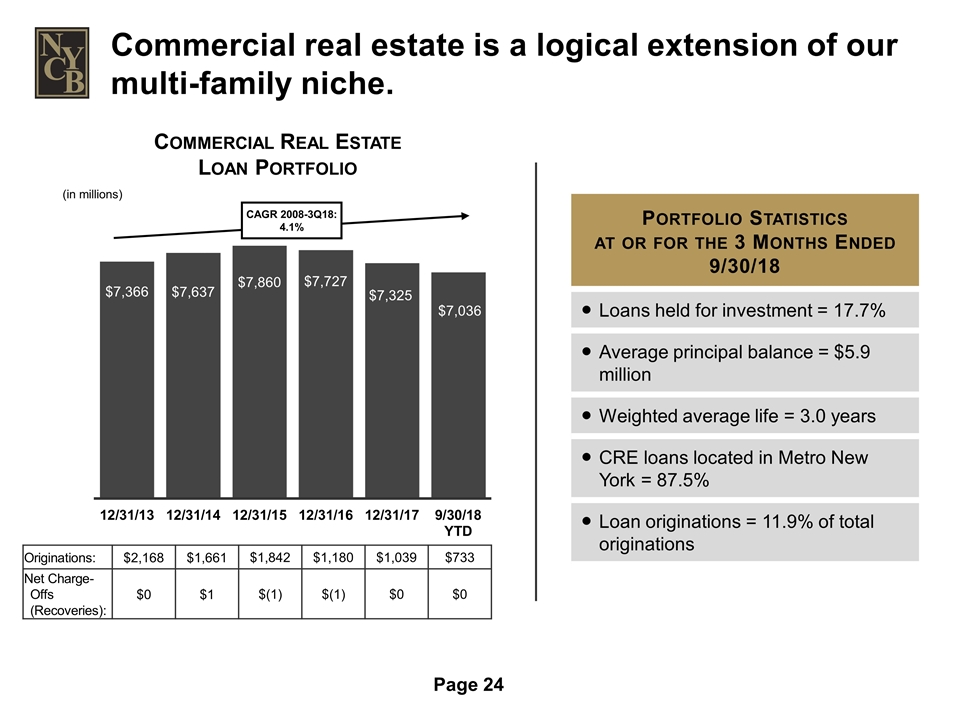
Commercial Real Estate Loan Portfolio (in millions) Originations: $2,168 $1,661 $1,842 $1,180 $1,039 $733 Net Charge-Offs (Recoveries): $0 $1 $(1) $(1) $0 $0 Commercial real estate is a logical extension of our multi-family niche. Portfolio Statistics at or for the 3 Months Ended 9/30/18 Loans held for investment = 17.7% Average principal balance = $5.9 million Weighted average life = 3.0 years CRE loans located in Metro New York = 87.5% Loan originations = 11.9% of total originations CAGR 2008-3Q18: 4.1%
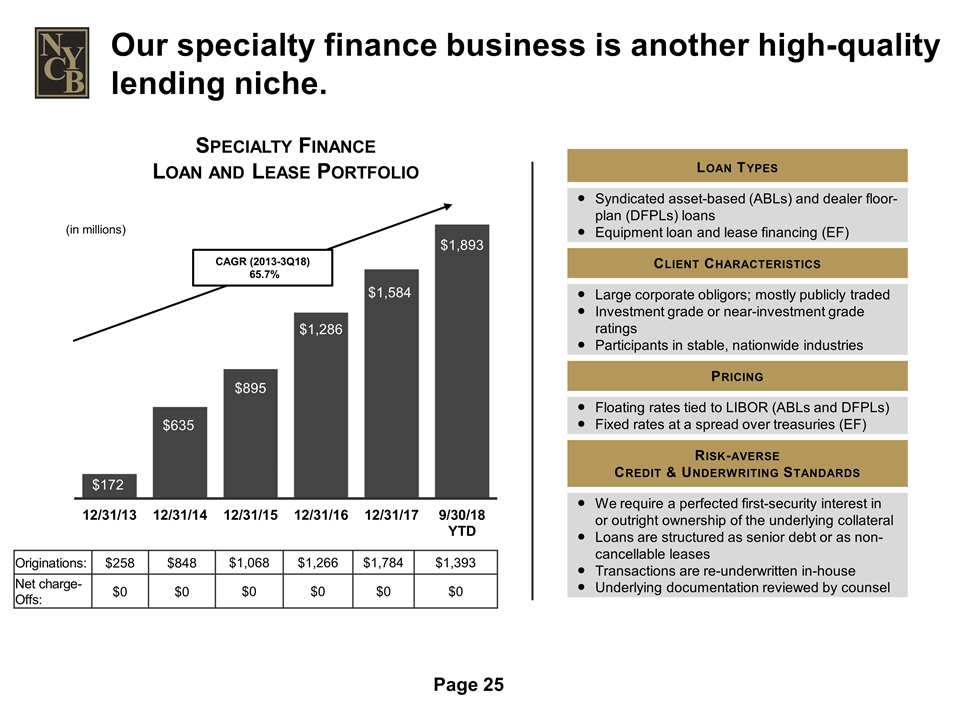
Specialty Finance Loan and Lease Portfolio (in millions) Originations: $258 $848 $1,068 $1,266 $1,784 $1,393 Net charge-Offs: $0 $0 $0 $0 $0 $0 Our specialty finance business is another high-quality lending niche. Loan Types Syndicated asset-based (ABLs) and dealer floor-plan (DFPLs) loans Equipment loan and lease financing (EF) Client Characteristics Large corporate obligors; mostly publicly traded Investment grade or near-investment grade ratings Participants in stable, nationwide industries Pricing Floating rates tied to LIBOR (ABLs and DFPLs) Fixed rates at a spread over treasuries (EF) Risk-averse Credit & Underwriting Standards We require a perfected first-security interest in or outright ownership of the underlying collateral Loans are structured as senior debt or as non-cancellable leases Transactions are re-underwritten in-house Underlying documentation reviewed by counsel CAGR (2013-3Q18) 65.7%
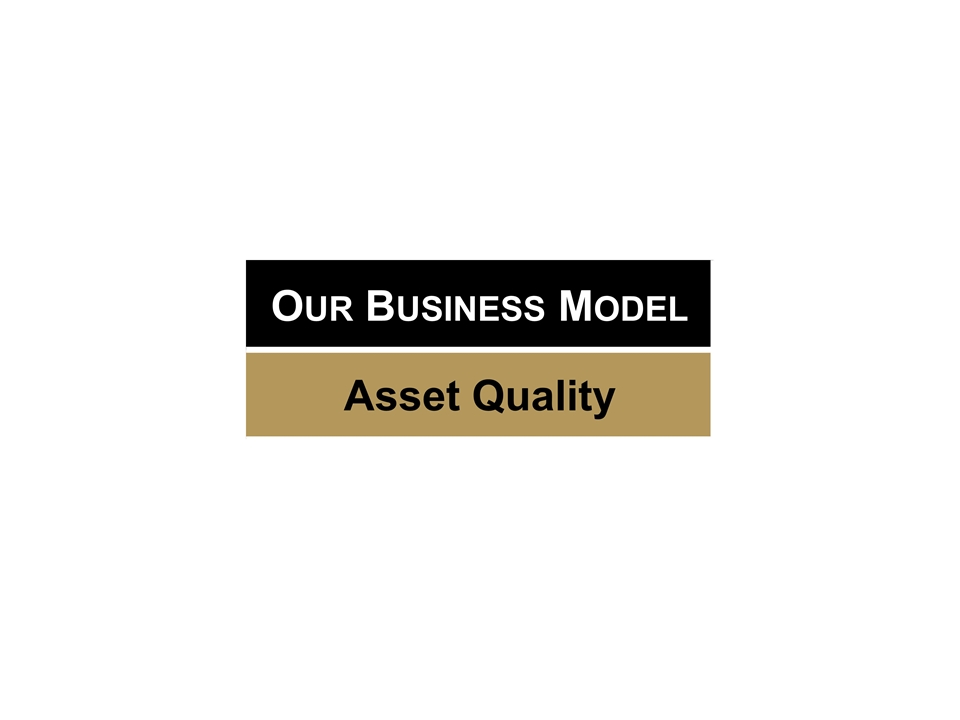
Our Business Model Asset Quality
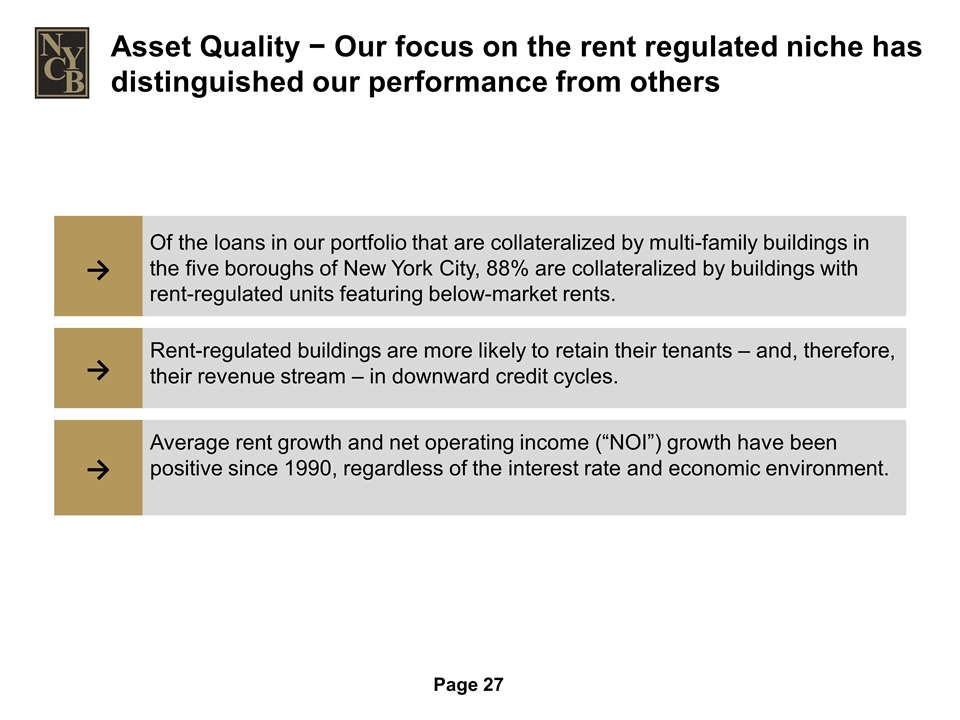
. → Of the loans in our portfolio that are collateralized by multi-family buildings in the five boroughs of New York City, 88% are collateralized by buildings with rent-regulated units featuring below-market rents. → Rent-regulated buildings are more likely to retain their tenants – and, therefore, their revenue stream – in downward credit cycles. → Average rent growth and net operating income (“NOI”) growth have been positive since 1990, regardless of the interest rate and economic environment. Asset Quality − Our focus on the rent regulated niche has distinguished our performance from others
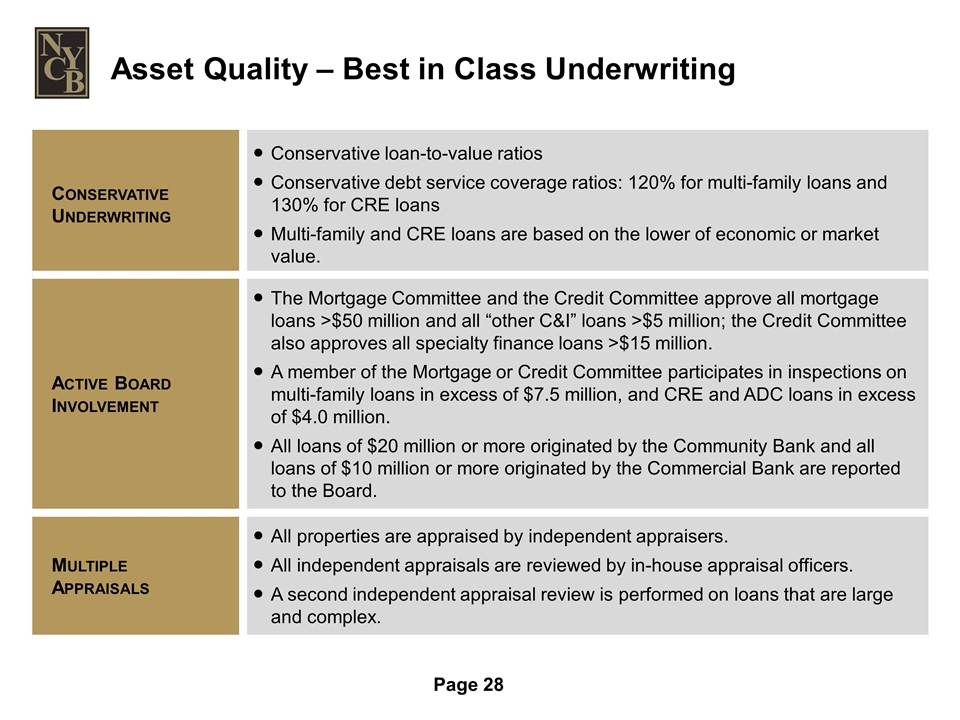
Asset Quality – Best in Class Underwriting Conservative Underwriting Conservative loan-to-value ratios Conservative debt service coverage ratios: 120% for multi-family loans and 130% for CRE loans Multi-family and CRE loans are based on the lower of economic or market value. Active Board Involvement The Mortgage Committee and the Credit Committee approve all mortgage loans >$50 million and all “other C&I” loans >$5 million; the Credit Committee also approves all specialty finance loans >$15 million. A member of the Mortgage or Credit Committee participates in inspections on multi-family loans in excess of $7.5 million, and CRE and ADC loans in excess of $4.0 million. All loans of $20 million or more originated by the Community Bank and all loans of $10 million or more originated by the Commercial Bank are reported to the Board. Multiple Appraisals All properties are appraised by independent appraisers. All independent appraisals are reviewed by in-house appraisal officers. A second independent appraisal review is performed on loans that are large and complex.
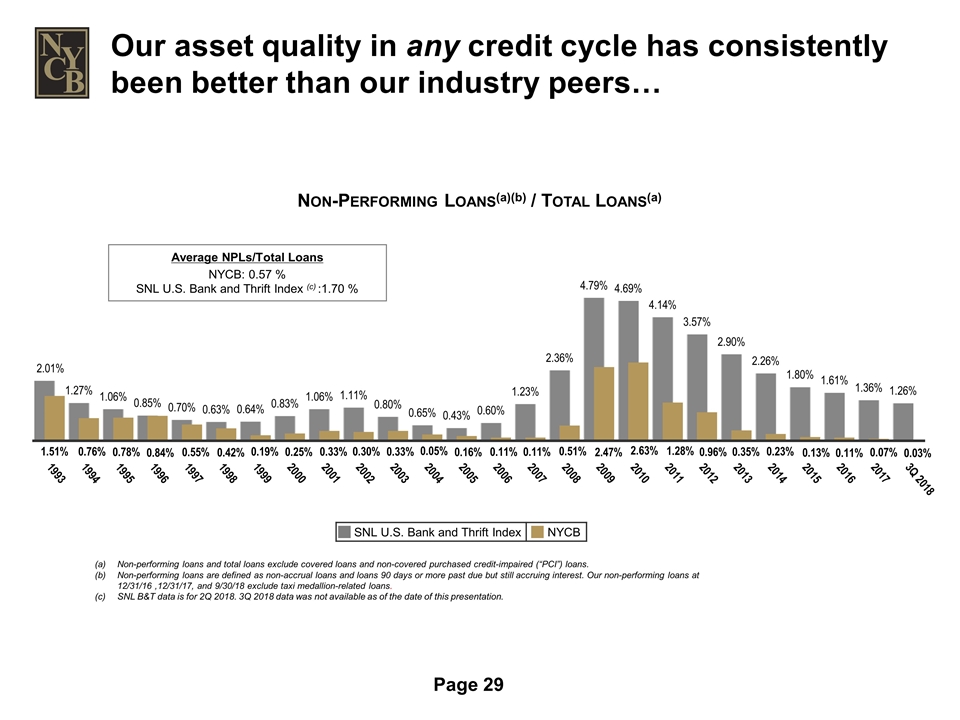
Non-Performing Loans(a)(b) / Total Loans(a) Non-performing loans and total loans exclude covered loans and non-covered purchased credit-impaired (“PCI”) loans. Non-performing loans are defined as non-accrual loans and loans 90 days or more past due but still accruing interest. Our non-performing loans at 12/31/16 ,12/31/17, and 9/30/18 exclude taxi medallion-related loans. SNL B&T data is for 2Q 2018. 3Q 2018 data was not available as of the date of this presentation. Average NPLs/Total Loans NYCB: 0.57 % SNL U.S. Bank and Thrift Index (c) :1.70 % SNL U.S. Bank and Thrift Index NYCB Our asset quality in any credit cycle has consistently been better than our industry peers…
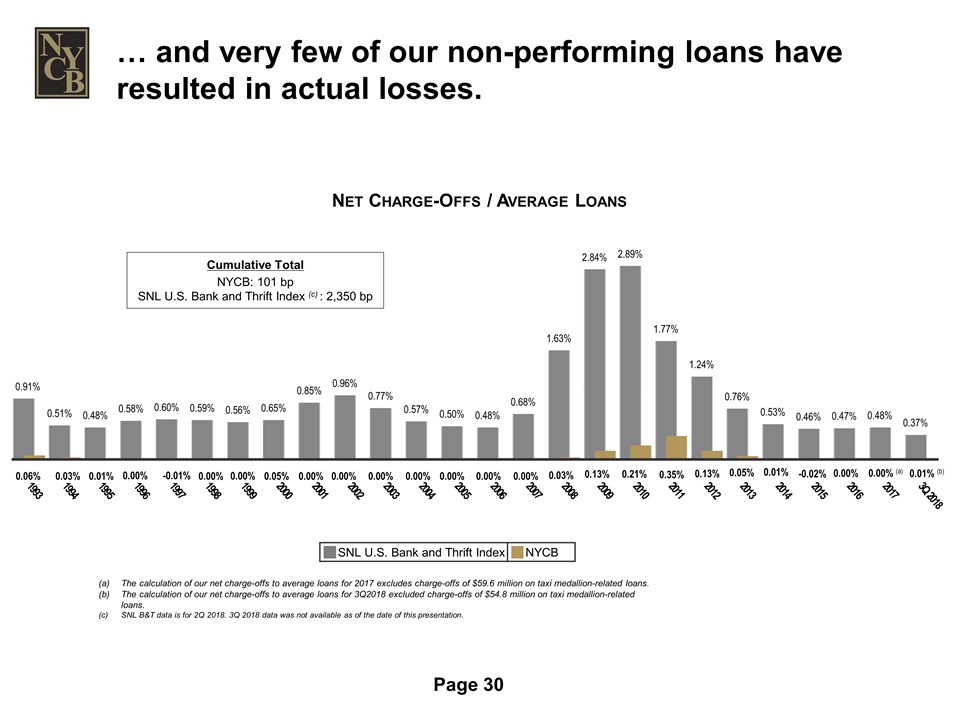
… and very few of our non-performing loans have resulted in actual losses. Net Charge-Offs / Average Loans Cumulative Total NYCB: 101 bp SNL U.S. Bank and Thrift Index (c) : 2,350 bp The calculation of our net charge-offs to average loans for 2017 excludes charge-offs of $59.6 million on taxi medallion-related loans. The calculation of our net charge-offs to average loans for 3Q2018 excluded charge-offs of $54.8 million on taxi medallion-related loans. SNL B&T data is for 2Q 2018. 3Q 2018 data was not available as of the date of this presentation. SNL U.S. Bank and Thrift Index NYCB
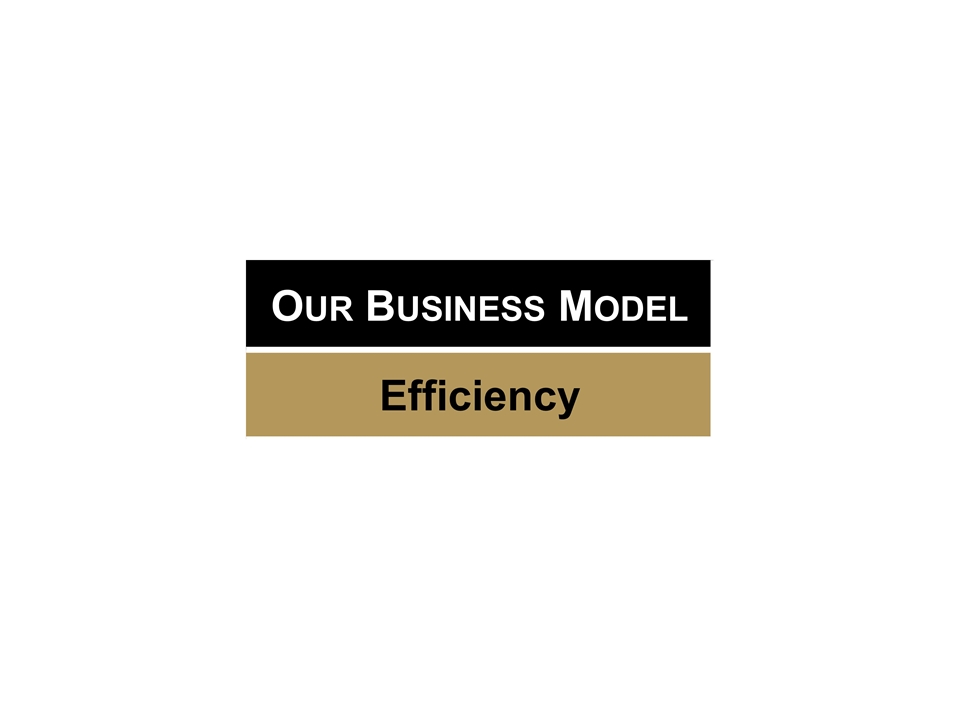
Our Business Model Efficiency
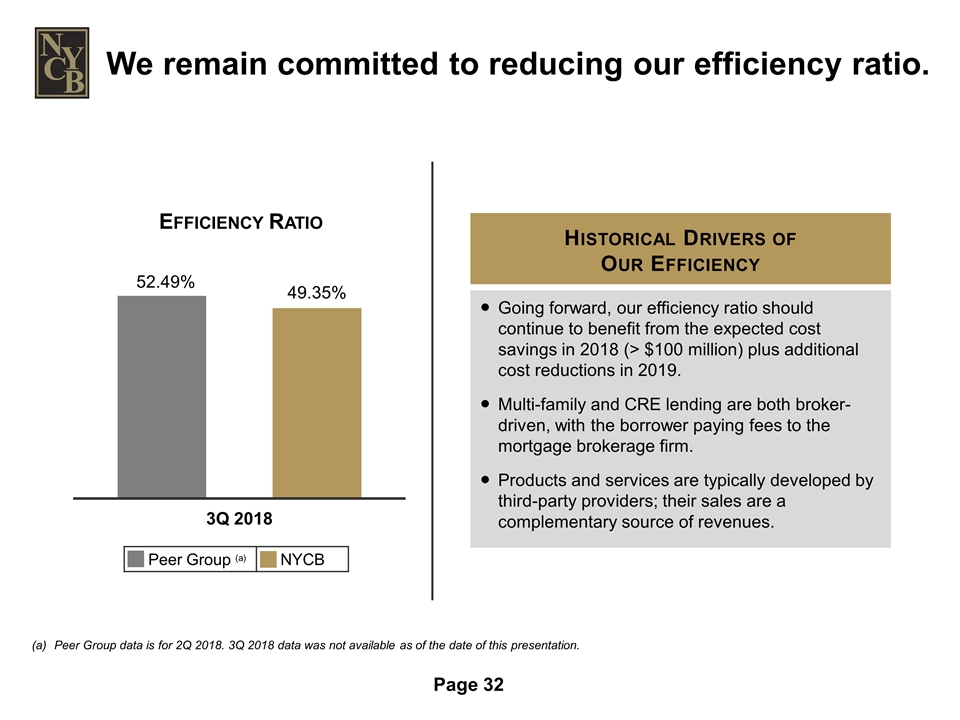
Historical Drivers of Our Efficiency Going forward, our efficiency ratio should continue to benefit from the expected cost savings in 2018 (> $100 million) plus additional cost reductions in 2019. Multi-family and CRE lending are both broker-driven, with the borrower paying fees to the mortgage brokerage firm. Products and services are typically developed by third-party providers; their sales are a complementary source of revenues. Efficiency Ratio Peer Group (a) NYCB We remain committed to reducing our efficiency ratio. Peer Group data is for 2Q 2018. 3Q 2018 data was not available as of the date of this presentation.
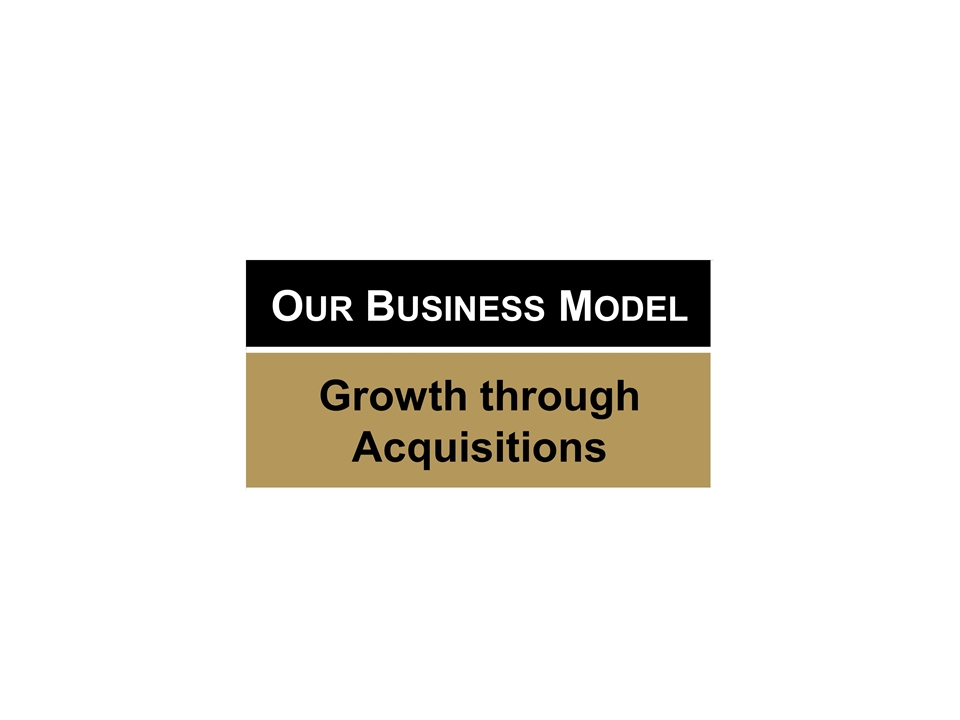
Our Business Model Growth through Acquisitions
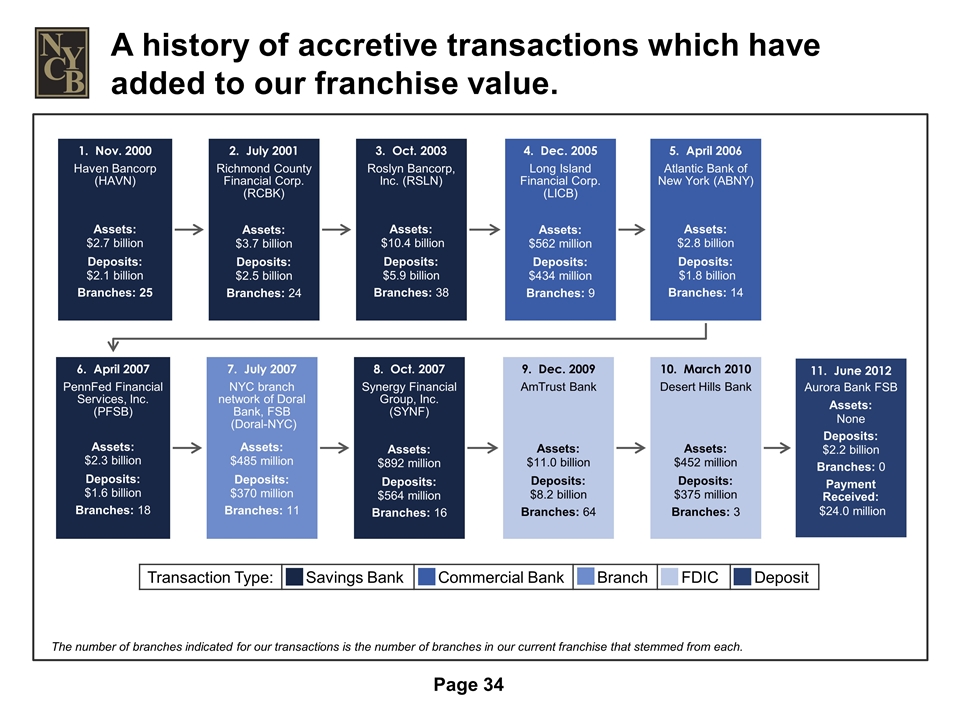
Transaction Type: Savings Bank Commercial Bank Branch FDIC Deposit A history of accretive transactions which have added to our franchise value. The number of branches indicated for our transactions is the number of branches in our current franchise that stemmed from each. 1. Nov. 2000 Haven Bancorp (HAVN) Assets: $2.7 billion Deposits: $2.1 billion Branches: 25 3. Oct. 2003 Roslyn Bancorp, Inc. (RSLN) Assets: $10.4 billion Deposits: $5.9 billion Branches: 38 4. Dec. 2005 Long Island Financial Corp. (LICB) Assets: $562 million Deposits: $434 million Branches: 9 2. July 2001 Richmond County Financial Corp. (RCBK) Assets: $3.7 billion Deposits: $2.5 billion Branches: 24 5. April 2006 Atlantic Bank of New York (ABNY) Assets: $2.8 billion Deposits: $1.8 billion Branches: 14 6. April 2007 PennFed Financial Services, Inc. (PFSB) Assets: $2.3 billion Deposits: $1.6 billion Branches: 18 7. July 2007 NYC branch network of Doral Bank, FSB (Doral-NYC) Assets: $485 million Deposits: $370 million Branches: 11 8. Oct. 2007 Synergy Financial Group, Inc. (SYNF) Assets: $892 million Deposits: $564 million Branches: 16 9. Dec. 2009 AmTrust Bank Assets: $11.0 billion Deposits: $8.2 billion Branches: 64 10. March 2010 Desert Hills Bank Assets: $452 million Deposits: $375 million Branches: 3 11. June 2012 Aurora Bank FSB Assets: None Deposits: $2.2 billion Branches: 0 Payment Received: $24.0 million
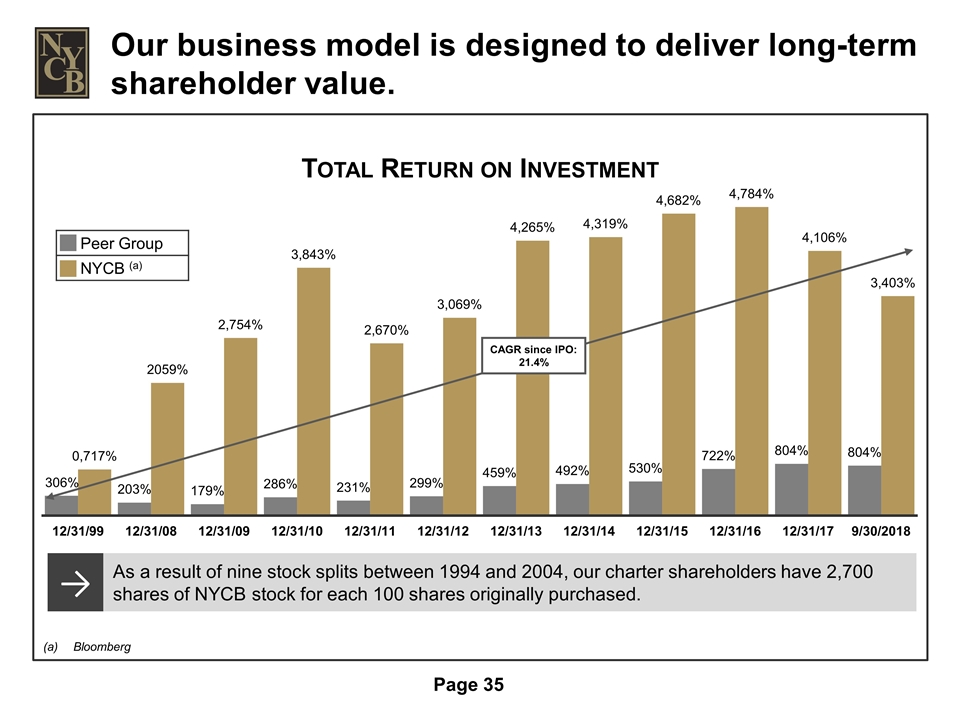
Our business model is designed to deliver long-term shareholder value. Total Return on Investment Bloomberg CAGR since IPO: 21.4% → As a result of nine stock splits between 1994 and 2004, our charter shareholders have 2,700 shares of NYCB stock for each 100 shares originally purchased. Peer Group NYCB (a)
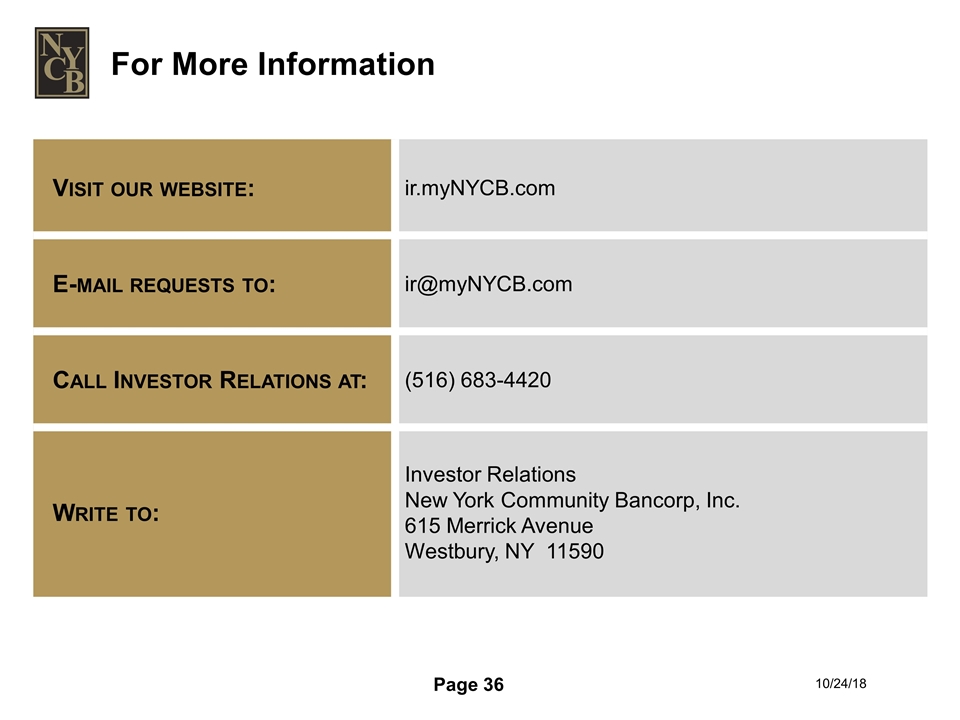
10/24/18 Visit our website: ir.myNYCB.com E-mail requests to: ir@myNYCB.com Call Investor Relations at: (516) 683-4420 Write to: Investor Relations New York Community Bancorp, Inc. 615 Merrick Avenue Westbury, NY 11590 For More Information
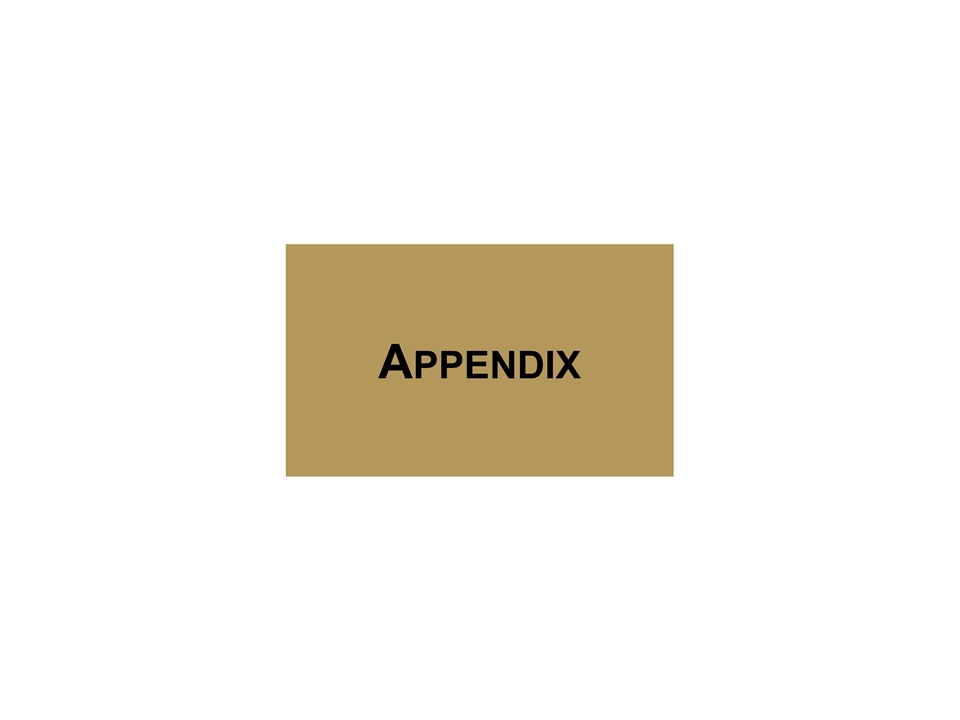
Appendix

While average stockholders’ equity, average assets, return on average assets, and return on average stockholders’ equity are financial measures that are recorded in accordance with U.S. generally accepted accounting principles ("GAAP"), average tangible stockholders’ equity, average tangible assets, return on average tangible assets, and return on average tangible stockholders’ equity are not. Nevertheless, it is management’s belief that these non-GAAP measures should be disclosed in our SEC filings, earnings releases, and other investor communications, for the following reasons: Average tangible stockholders’ equity is an important indication of the Company’s ability to grow organically and through business combinations, as well as our ability to pay dividends and to engage in various capital management strategies. Returns on average tangible assets and average tangible stockholders’ equity are among the profitability measures considered by current and prospective investors, both independent of, and in comparison with, our peers. We calculate average tangible stockholders’ equity by subtracting from average stockholders’ equity the sum of our average goodwill and core deposit intangibles (“CDI”), and calculate average tangible assets by subtracting the same sum from our average assets. Average tangible stockholders’ equity, average tangible assets, and the related non-GAAP profitability measures should not be considered in isolation or as a substitute for average stockholders’ equity, average assets, or any other profitability or capital measure calculated in accordance with GAAP. Moreover, the manner in which we calculate these non-GAAP measures may differ from that of other companies reporting non-GAAP measures with similar names. The following table presents reconciliations of our average common stockholders’ equity and average tangible common stockholders’ equity, our average assets and average tangible assets, and the related GAAP and non-GAAP profitability measures at or for the three months ended September 30, 2018: To calculate our returns on average assets and average common stockholders’ equity for a period, we divide the net income available to common shareholders generated during that period by the average assets and the average common stockholders’ equity recorded during that time. To calculate our returns on average tangible assets and average tangible common stockholders’ equity for a period, we adjust the net income available to common shareholders generated during that period by adding back the amortization of CDI, net of tax, and then divide that adjusted net income by the average tangible assets and the average tangible common stockholders’ equity recorded during that time. Reconciliations of GAAP and Non-GAAP Measures (dollars in thousands) For the Three Months Ended September 30, 2018 Average common stockholders’ equity $ 6,301,525 Less: Average goodwill and core deposit intangibles (2,436,131) Average tangible common stockholders’ equity $ 3,865,394 Average assets $50,608,283 Less: Average goodwill and core deposit intangibles (2,436,131) Average tangible assets $48,172,152 Net income available to common shareholders (1) $98,565 Add back: Amortization of core deposit intangibles, net of tax -- Adjusted net income (2) $98,565 GAAP: Return on average assets 0.84% Return on average common stockholders’ equity 6.26 Non-GAAP: Return on average tangible assets 0.89 Return on average tangible common stockholders’ equity 10.20
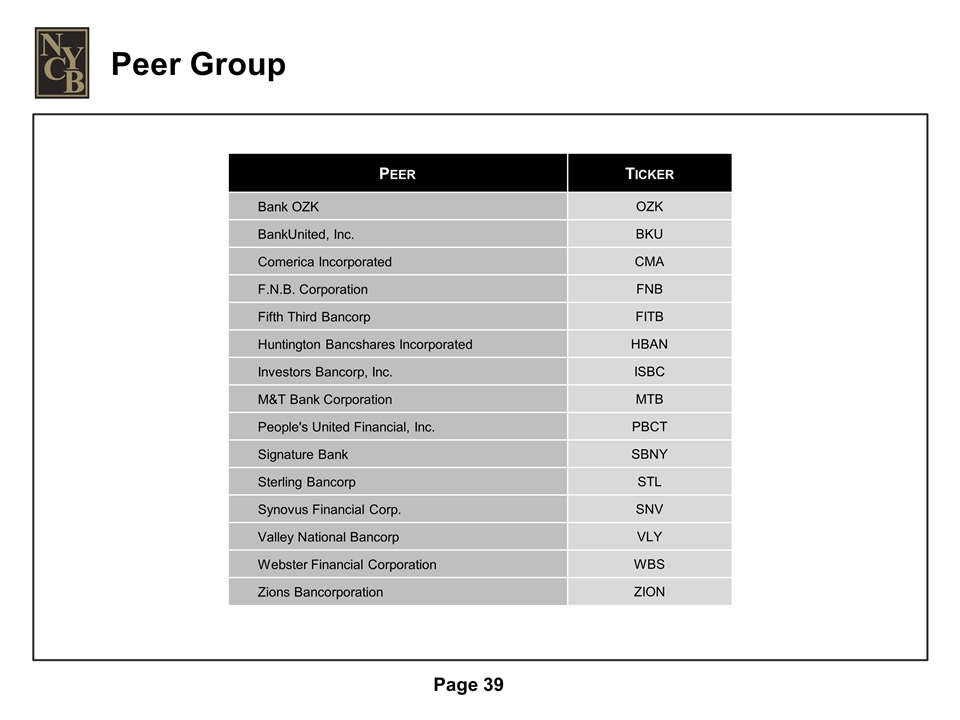
Peer Group Peer Ticker Bank OZK OZK BankUnited, Inc. BKU Comerica Incorporated CMA F.N.B. Corporation FNB Fifth Third Bancorp FITB Huntington Bancshares Incorporated HBAN Investors Bancorp, Inc. ISBC M&T Bank Corporation MTB People's United Financial, Inc. PBCT Signature Bank SBNY Sterling Bancorp STL Synovus Financial Corp. SNV Valley National Bancorp VLY Webster Financial Corporation WBS Zions Bancorporation ZION
